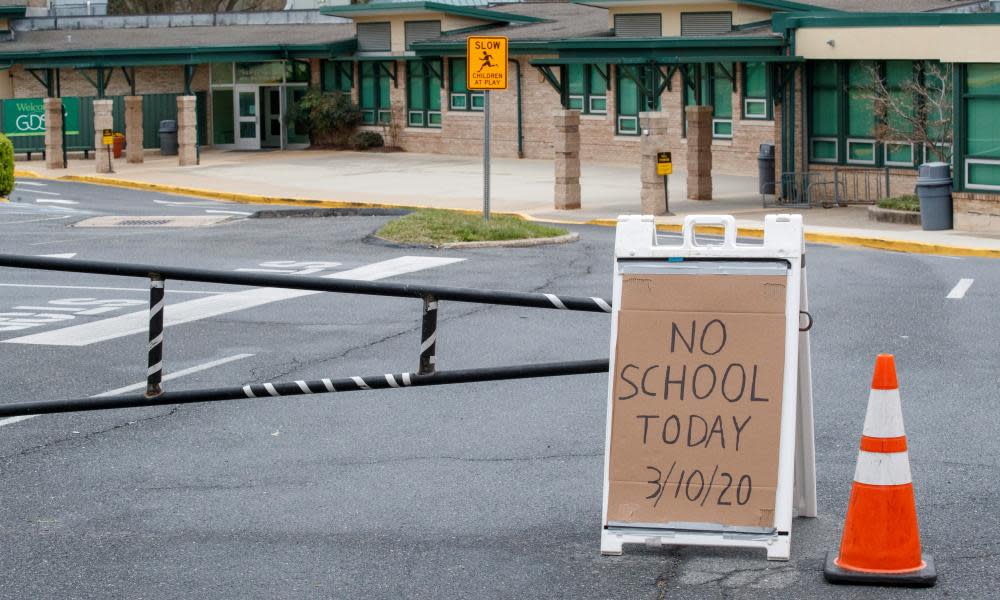'I literally cried': parents grapple with impact of US school closures

The closure of New York City public schools until at least 20 April due to the coronavirus outbreak, announced on Sunday, has underscored difficulties faced by millions of parents across the entire US.
While many recognize that Covid-19 needs to be controlled, parents and advocates find themselves not only grappling with daytime childcare challenges but worrying about the welfare of students who rely upon schools for far more than education.
Thirty-three states have decided to shutter public schools due to coronavirus concerns, Education Week reported. In addition to district closures, a minimum of 64,000 public schools have shut their doors or plan to close.
These closures have impacted a minimum of 32.5 million pupils, Education Week said, out of 50.8 million students at 98,277 public schools in the US. This means more than 60% of students have been affected in some way. Many private schools have also closed.
New York City’s public school system claims to have 1,126,501 students, making it the largest such district in the US and providing a sense of scale when it comes to the impact on families who desperately need schools for childcare and even a source of food. In addition to free meals, New York City public schools provide crucial services for students with a wide range of needs, among them speech, physical and disability-related therapy programs and counseling.
“As we learn more about Covid-19 every day, we are keeping every possible option on the table to keep New Yorkers safe,” Mayor Bill de Blasio said.
“That’s why we are asking the people of our city to make hard choices as we introduce more restrictive measures to create greater social distancing – including the temporary closure of our school buildings. We all need to change our lives – in ways both big and small – to keep each other safe.”
New York City public schools will launch remote learning on 23 March. The 300,000 students without internet-connected devices will receive one to complete schoolwork and 25,000 iPads are scheduled to be distributed next week. Students will be able to pick up meals, De Blasio’s office said.
Advocates for Children of New York, a group defending low-income students’ rights, reported last October that 114,085 schoolchildren in the city are homeless, or 10%.
“While we are not questioning the decision to close schools to address this public health crisis, remote learning is likely to be a struggle for many families, including families with children who need more support to learn successfully,” Kim Sweet, the group’s executive director, said in a statement.
“It will be important for schools to make extra effort to ensure that remote learning benefits all students.”
The United Federation of Teachers, which had slammed De Blasio when he kept schools open, lauded the decision to close.
“The administration has made the right decision: closing the schools is a critical step to reduce the spread of the virus and to help preserve the health of our students, their families and our staff,” the UFT president, Michael Mulgrew, said.
Some parents are worried about what will happen to their children now.
“I literally cried – I was crying all afternoon,” said Grisel Cardona, a mother of three and parent advocate in the Bronx, of the news of the closures.
Cardona’s nine-year-old son has autism, her seven-year-old daughter has special needs and her two-year-old son attends an “early intervention” program where he gets feeding therapy as he cannot chew anything large, she said.
“I cried because what went through my head was: ‘What do I tell my son?’ We have a routine, everyday, that we follow. We’re not going to get up at six in the morning to get dressed and go on the bus.
“There’s no school, this is why his question to me was: ‘What’s the coronavirus? [But] I take a bath everyday. Am I going to die?’
“We both cried because it’s scary. He’s like, ‘Mommy, this is dangerous. What are we going to do?’ It was so emotional, then I kept thinking about his services. What am I going to do?
“Children will regress if they don’t get the services that they need.”
The US Department of Agriculture’s Food and Nutrition Services, which administers the National School Lunch Program, said it was taking steps to ensure that children affected by school closures still receive meals.
The program provides low-cost or free lunches to schoolchildren in public and not-for-profit private schools, as well as residential childcare institutions, on school days.
A spokesperson for the USDA said officials there have issued waivers, so meals can be served outside of a “congregate” setting. All 50 states, as well as Washington DC and Puerto Rico, have received such approvals in response to the public health crisis.
One New York City parent who did not want to be named, whose 14-year-old son attends a private school which is now closed, said she supported school closures but understood the difficulties for parents.
“I think that there’s a fine line between both decisions, because on the one hand, you are looking out for health and public safety [and] on the other hand, you want to continue your son, your child’s education, so there’s two different sides of the argument,” the parent said.
“But, I always believe it’s better to be safe than sorry when it comes to health, so I’m glad they made that decision.”
Still, the parent said, “there are a lot of things that public officials have to figure out.”

